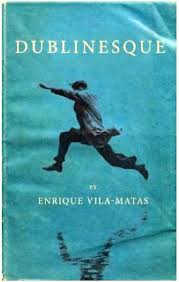The Novel of Micro-Events
Comical and touching, from time to time, he glances furtively at the croutons.
Samuel Riba has closed his small, independent publishing company (he fears his “noble branch” of the trade is dying out), he’s despondent that he never found the great writer he dreamed of publishing, he’s unhappily on the wagon and trying to save his marriage, he hears voices, and he thinks someone is following him. Riba, who continually mediates his own life through the world of literature he loves deeply, but nevertheless “fears his exaggerated fanaticism for literature was probably harmful,” is suddenly afraid his life is about to become someone else’s novel. His response? To gather up some friends and go to Dublin on Bloomsday, June 16, and hold a mock funeral for The Age of Gutenberg.
Enrique Vila-Matas’ Dublinesque (the titles comes from a poem by Philip Larkin) is a book born under the sign of James Joyce – especially “The Dead” and Ulysses – and serves as an extended homage to the line of modernist literature that followed. Dublinesque, in which Riba suffers from “a publisher’s malady,” also serves as a companion piece to his earlier novel Montano’s Malady, with its inventory of writers who suffered from writer’s block or “writer’s malady.” But, as Riba begins to realize, publishing and literature have also provided him with a way to hide from himself for most of his life. What Riba really wants is a personal resurrection, to recover an earlier self through “a journey toward enthusiasm.”
In the four books translated into English so far – Dublinesque, Never Any End to Paris, Montano’s Malady, and Bartleby & Co. – Vila-Matas explores the boundaries between life and literature and what happens when the two become confused with each other. In each of these books, Vila-Matas is also preoccupied with psychic paralysis in many forms, but most notably writer’s block and procrastination. In Dublinesque, for example, Riba decides in the opening pages to go to Dublin, but spends the next 140 pages dithering, wandering, having panic attacks, and rechecking his plans. But in the character Riba, we see the first truly tragic character Vila-Matas has given us yet. After Riba and his cohorts hold their mock funeral and tramp around Dublin seeing sights associated with Ulysses, nothing changes for the better. Riba’s resurrection is doomed, he begins drinking again, and his wife leaves him. He knows now that literature cannot save him, although it clearly helped drive her away. “Literature had nothing to say to her; it didn’t change her vision of the world or make her see things in a different way.” But even though he has lost everything, Riba still cannot stop mediating his life through literature, and the novel that begin with Joyce ends, appropriately, with Samuel Beckett, as Riba spends the final forty pages commiserating with himself in a rocking chair like Beckett’s Murphy.
As Riba sees it, his life, like Murphy, has a “central story in which nothing seemed to happen, but in reality lots of things were going on, because in fact that story was full of brutal micro-events.” It’s no great revelation for me to observe that literature and life are two entirely different planes of existence. A good deal of the literature since Joyce serves as a reminder that our lives are, in fact, exceedingly banal 99.9% of the time. Where Joyce and Beckett have succeeded is in making generation after generation want to read about the banal lives of others – Joyce largely through his gift for language and his celebratory spirit and Beckett through his gift for compelling characters and drama. I’m over-generalizing here, I realize, but my point is that it’s a tough job to be able to lift a novel comprised of endlessly banal micro-events above its inherent, self-imposed banality. In general, Dublinesque succeeds – for me. But just barely. I understand Riba’s world, the names he relentlessly drops, the books he intensely ponders and discusses, the sly, amusing references. It’s all great fun for those in the know and, at times, Dublinesque is intensely, if darkly, humorous. But Riba is no Leopold Bloom. Furthermore, anyone can pick up a book by Joyce or Beckett (Finnegan’s Wake being the obvious exception) and make sense of the world of Bloom or Malone or Molloy or Murphy without needing prior knowledge of the esoteric world of modernist and contemporary literature. Vila-Matas, like his creation Samuel Riba, seems both deliberate and stubborn about using literature as a crutch, and I think the result is a unique, occasionally brilliant, but frequently narrow, body of work.
Enrique Vila-Matas. Dublinesque. New Directions, 2012. Translated by Anne McLean and Rosalind Harvey from the Spanish Dublinesca, originally published in 2010.


Excellent review. This is on my list for 2013, and, even if my hopes are slightly dampened, it feels like a book I must read.
Seamus, Dublinesque is full of things I liked and it is my favorite of the four Vila-Matas books so far in English.� I just worry that he’s painting himself into a small corner.� – Terry
________________________________
And speaking of Vila-Matas and Elfriede Jelinek: Maybe you need to take a look to “Doctor Pasavento” (written by Vila-Matas too). This is another story of Robert Walser.
Rodrigo, Thanks for the note about Doctor Pasavento. I hope others will take a look. Alas, my Spanish will barely get me through the train station and a menu. It is very puzzling to me that there are so many of Vila-Matas’ books that have not been translated.
“…ABOUT Robert Walser”. (sorry)